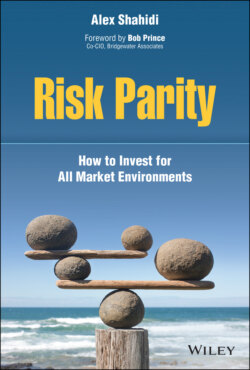Risk Parity

Реклама. ООО «ЛитРес», ИНН: 7719571260.
Оглавление
Alex Shahidi. Risk Parity
Table of Contents
List of Tables
List of Illustrations
Guide
Pages
Praise for Risk Parity
Risk Parity. How to Invest for All Market Environments
Foreword
Preface
Acknowledgments
About the Author
Introduction
NOTE
CHAPTER ONE What Is Risk Parity?
RISK PARITY IS ALL ABOUT BALANCE
A Smoother Path
THE SOURCE OF RETURNS
WHAT IS RISK?
THE 60/40 PORTFOLIO IS NOT WELL‐BALANCED
RISK PARITY FRAMEWORK OVERVIEW
PEER GROUP RISK
CHAPTER TWO Two Steps to Build a Well‐Balanced Portfolio
STEP 1: WHICH ASSET CLASSES TO REDUCE RISK?
The Economic Environment Drives Asset‐Class Returns
Four Diverse Asset Classes
STEP 2: HOW TO STRUCTURE EACH ASSET CLASS TO HAVE EQUITY‐LIKE RETURNS
Putting It All Together
CHAPTER THREE Equities
WHAT ARE STOCKS?
HOW DO STOCKS PERFORM ACROSS DIFFERENT ENVIRONMENTS?
Growth/Inflation Bias: Conceptual Framework
Growth/Inflation Bias: Historical Returns
WHAT IS THE BEST WAY TO INVEST IN EQUITIES?
STOCK MARKET CYCLES
ARE THERE EXTRAORDINARY ENVIRONMENTS TO CONSIDER?
SUMMARY
NOTE
CHAPTER FOUR Treasuries
WHAT ARE TREASURIES?
HOW DO TREASURIES PERFORM ACROSS DIFFERENT ENVIRONMENTS?
Growth/Inflation Bias: Conceptual Framework
Growth/Inflation Bias: Historical Returns
WHAT IS THE BEST WAY TO INVEST IN TREASURIES?
ARE THERE EXTRAORDINARY ENVIRONMENTS TO CONSIDER?
SUMMARY
CHAPTER FIVE TIPS
WHAT ARE TIPS?
HOW DO TIPS PERFORM ACROSS DIFFERENT ENVIRONMENTS?
Growth/Inflation Bias: Conceptual Framework
Growth/Inflation Bias: Historical Returns
WHAT IS THE BEST WAY TO INVEST IN TIPS?
ARE THERE EXTRAORDINARY ENVIRONMENTS TO CONSIDER?
SUMMARY
NOTES
CHAPTER SIX Commodities
WHAT ARE COMMODITIES?
HOW DO COMMODITIES PERFORM ACROSS DIFFERENT ENVIRONMENTS?
Growth/Inflation Bias: Conceptual Framework
Commodity Futures versus Commodity Equities
WHAT IS THE BEST WAY TO INVEST IN COMMODITIES?
OTHER CONSIDERATIONS
SUMMARY
CHAPTER SEVEN Other Asset Classes
EQUITY SUBGROUPS
NON‐US BONDS
CORPORATE BONDS
MUNICIPAL BONDS
COMMERCIAL REAL ESTATE
PRIVATE EQUITY
HEDGE FUNDS
CRYPTOCURRENCIES
CASH
SUMMARY
CHAPTER EIGHT Risk Parity Portfolio Summary
CONCEPTUAL FRAMEWORK
TARGET ALLOCATION
RISK PARITY WITHOUT LEVERAGE OR WITH MORE LEVERAGE
SUMMARY
NOTE
CHAPTER NINE Risk Parity Portfolio Historical Returns
RETURNS SINCE 1998 (TIPS INCEPTION)
RETURNS SINCE 1970
RETURNS SINCE 1926
SUMMARY
NOTES
CHAPTER TEN The Timeliness of Risk Parity
THE CENTRAL BANK
The Fed's Main Policy Tool: Interest Rates
The Fed's Emergency Policy Tool: QE
The Fed's New Policy Tool: Modern Monetary Theory
THE DELEVERAGING HEADWIND
RISE OF POPULISM
THE NET OUTCOME OF MAJOR HEADWINDS AND TAILWINDS IS HIGHLY UNCERTAIN
THE NEED FOR LIQUIDITY, LOW FEES, AND TAX EFFICIENCY
CHAPTER ELEVEN The Rebalancing Boost
CONCEPTUAL FRAMEWORK: BUY LOW, SELL HIGH
LOW CORRELATION AND HIGH VOLATILITY
THE REBALANCING BOOST APPLIED TO THE RISK PARITY PORTFOLIO
SUMMARY
CHAPTER TWELVE Efficient Implementation
SIMPLICITY
HIDDEN LINE ITEMS
LOW COST
HIGH LIQUIDITY
LOW TAXES
TRANSPARENCY
LEVERAGE
SUMMARY
NOTES
CHAPTER THIRTEEN When Does Risk Parity Underperform?
BREAK GLASS IN CASE OF EMERGENCY
RISKY ASSETS VERSUS CASH
CASH IS KING DURING TWO ENVIRONMENTS
1. Cash Rates Unexpectedly Rise
2. Panic
RARE AND SHORT‐LIVED PERIODS
CONCEPTUALLY NETTING THE IMPACT TO ASSET‐CLASS PRICES
ABSOLUTE VERSUS RELATIVE UNDERPERFORMANCE
SUMMARY
CHAPTER FOURTEEN FAQs
DOES IT MAKE SENSE TO OWN LONG DURATION BONDS WITH LOW INTEREST RATES?
Concerns about Low Potential Returns
The Risk of Rising Interest Rates
HOW DOES RISK PARITY FIT WITHIN THE TOTAL PORTFOLIO?
Highly Liquid
Low Fees
Available to All Investors
Passive versus Active
Diversification
Transparency
Tax Efficiency
Risk Parity as the Total Portfolio
DO ASSET CLASS GAINS AND LOSSES NET OUT TO ZERO?
DOES DIVERSIFICATION WORK DURING A CRISIS?
IF RISK PARITY IS SO OBVIOUS, WHY ISN'T EVERYONE INVESTING THIS WAY?
DOES REBALANCING MORE OR LESS FREQUENTLY MAKE A BIG DIFFERENCE?
CHAPTER FIFTEEN Conclusion
Index
WILEY END USER LICENSE AGREEMENT
Отрывок из книги
“A must‐read for anyone investing in the market who wants to maximize upside return while minimizing downside risk. Alex has skillfully crafted a ‘how to’ book that spells out, step‐by‐step, building a balanced portfolio that can generate equity‐like returns across a diverse spectrum of asset classes without the concomitant risk of equity securities, a strategy that will deliver in the long run no matter the market or economic environment. His proven, no‐nonsense approach is communicated in such a refreshingly straightforward manner that it can be easily understood and applied in practice by novice investors while simultaneously educating and informing the savviest wealth manager. If you're laboring under the belief that a balanced portfolio is 60% stocks and 40% bonds, then this book is for you. Risk Parity will change your life—and your wallet!”
—Lloyd Greif, President and CEO, Greif & Co.; Founder, Lloyd Greif Center for Entrepreneurial Studies at the University of Southern California's Marshall School of Business
.....
The rate of return of an investment is a relatively straightforward notion to understand. You invest $100 and in one year your portfolio is worth $110. This means you earned a 10% return. Risk, on the other hand, is multifaceted and more challenging to observe and measure. I think of risk across three different dimensions:
Volatility is the standard measure of risk in the investment industry. The technical metric is standard deviation, which is a statistical of the dispersion of an investment's price change around its average over time. The more the price fluctuates around its average return, the greater the volatility. In general, a lower volatility is preferred over a higher volatility for the same return because the odds of actually earning the average return improve. This is because investors are less likely to get in and out at inopportune times.
.....